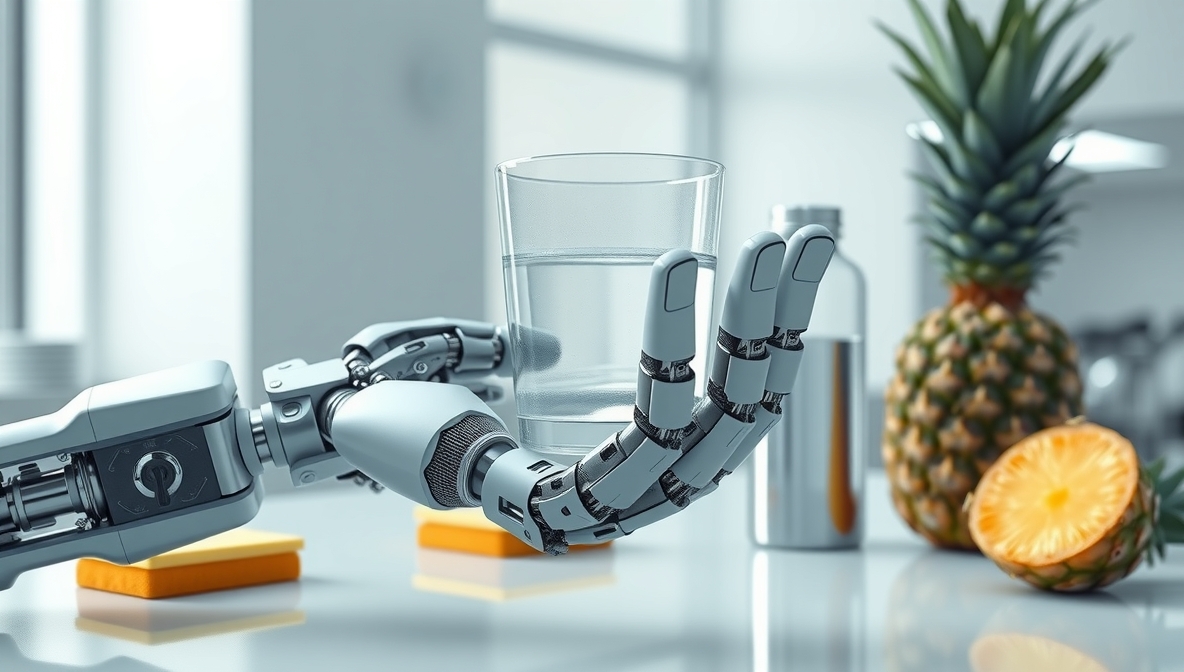An innovative robotic hand recently developed is capable of gently picking up a wide variety of objects – from delicate plastic cups to heavy, prickly pineapples.
Human hands are remarkably complex systems. The skeleton provides a stable structure, muscles adjust to different weights, and the skin – with its touch, pressure, and temperature sensors – provides immediate feedback about the object we’re touching. Flexible joints allow us to perform precise actions like typing or using a game controller without conscious effort.
A team of researchers from Johns Hopkins University has succeeded in recreating these features in an advanced prosthetic robotic hand. At the center of the hand is a 3D-printed skeleton. Each finger includes three independent silicone joints operated by air pressure. A three-layer “electronic skin” covering on the fingertips allows the hand to measure the required grip strength in real time. The hand is controlled by detecting electrical signals from the forearm muscles only.
In conducted experiments, healthy participants used the hand to pick up various objects – from soft toys and dish sponges, which it grasped gently, to heavy metal water bottles and prickly pineapples, where it adjusted its grip strength accordingly. In all cases, it successfully lifted the objects without dropping them or causing damage.
The main goal of the project was to create a prosthetic hand based on the physical and sensory capabilities of the human hand – a more natural prosthesis that functions and feels like a lost limb.
Evolution of Prosthetics
Prosthetic hands have undergone significant development throughout history. One of the first prosthetic hands, made of metal in the Middle Ages, included joints that could be moved passively with the help of the other hand.
Today, soft robotics technology is revolutionizing the field. Unlike rigid and inflexible materials, hands made of soft materials can handle delicate objects without distorting or crushing them. Integrated sensors for pressure and temperature make them more human-like through sensory feedback.
However, soft robotic hands have a significant disadvantage – they cannot consistently generate the same force needed to lift heavy objects. Even with multiple joints and a dynamic palm, soft robotic hands struggle to identify different textures compared to their rigid counterparts. Additionally, they are relatively weak – existing soft robotic hands can lift only about 2.8 pounds.
In contrast, our human hands combine a rigid skeleton with soft tissues – muscles and tendons – capable of stretching, rotating, and contracting. Pressure sensors in our skin provide immediate feedback: are we pressing on a soft toy, holding a slippery coffee mug, or operating an electronic device?
This is why current prosthetic designs combine skeletons with artificial “muscles.”
For example, the commercially available LUKE arm includes a metal and plastic skeleton that gives it strength and stability. Its fingertips contain soft materials that improve dexterity. The prosthesis can grasp objects using various inputs – for instance, electrical signals from muscles or a foot pedal that allows switching between different grip levels. However, the hand is still mostly rigid with limited mobility. The thumb and index finger can bend separately, but the rest of the fingers move together.
Another issue is feedback. Human fingers use touch to calibrate their grip. Each of the three layers of skin encodes different sensations through various biological receptors. The outer layer senses light touch and slow vibration, like hair brushing against the hand. Deeper layers detect pressure: the texture and weight of a heavy object, for example.
In 2018, the research team developed an electronic skin inspired by human skin. The material, called E-dermis, sensed textures and transmitted them to the remaining nerves in an amputee’s arm through gentle electrical stimulation. The skin used piezoresistive sensors, so pressure changed how the sensors conducted electricity. Prosthetic fingertips coated with these sensors allowed an upper-limb amputee to identify various sensations, including pressure.
The researchers explain the importance through an everyday example: when a person holds a coffee cup, how do they know they’re about to drop it? The palm and fingertips send signals to the brain that the cup is slipping. The team’s system is influenced by the nervous system – it simulates the hand’s touch receptors to produce nerve-like signals, so the prosthesis’s “brain” (its computer) understands if something is hot or cold, soft or hard, or slipping from the grip.
The Technology Behind the New Hand
The new design incorporates electronic skin in a hybrid hand that mimics a human hand.
The thumb has two silicone joints and the fingers have three. Each joint can flex independently. The joints connect to a rigid 3D-printed skeleton and are operated by a pneumatic system.
Compared to prostheses made only of soft components, the skeleton adds strength and can support heavier weights. The hand’s fingertips are covered with E-dermis patches the size of a fingernail. Each finger bends naturally, folding into the palm or stretching outward.
The hand is controlled by electrical signals from the user’s forearm muscles. Such devices, called myoelectric prostheses, connect to living nerve endings above the amputation site. When a person thinks about moving the hand, a microprocessor translates the nerve signals into movement commands.
A series of experiments with healthy volunteers demonstrated the hand’s dexterity. Participants wore a sleeve on their forearms to capture electrical signals in their arms – similar to those used by amputees – and transmit them to the robotic hand.
With minimal training, volunteers were able to grasp various objects of different sizes, weights, and textures. The hand gently picked up a sponge without crushing it and handled various fruits – apple, orange, clementine – without causing damage. The prosthesis proved capable of lifting heavier items as well, such as a small stone statue and a metal water bottle.
But the most impressive example, according to the researchers, was when the hand held a fragile plastic cup full of water using only three fingers. The hand did not distort the cup and did not spill a drop of water.
Overall, the hand achieved an impressive accuracy rate of 99.7 percent in handling 15 different everyday items, quickly adjusting its grip to prevent drops, spills, or other mishaps.
It’s important to note that the device has not yet been tested on people who have lost a hand, and there are still areas for improvement. Adding a tendon-like structure between the artificial fingers could enhance their stability. Mimicking hand movement could further improve flexibility. Adding additional sensors, such as temperature sensors, could bring the engineered hand even closer to the capabilities of the human hand.
Improving the dexterity of prosthetic hands is essential for next-generation prostheses. Future robotic hands will need to integrate seamlessly into daily life and deal with all the variety we face. This is why a hybrid robot, designed like a human hand, is so valuable – it combines soft and rigid structures, just like our skin, tissues, and bones.












